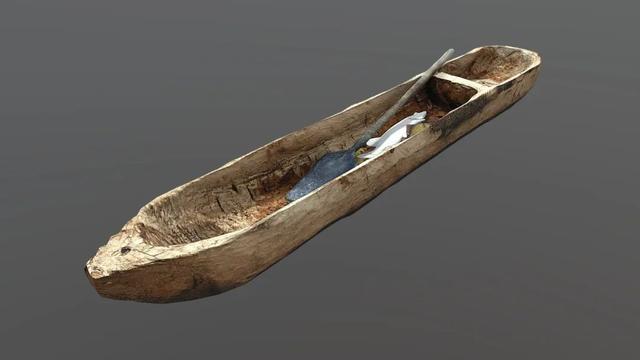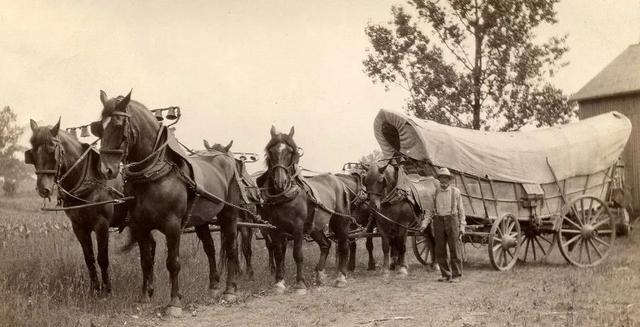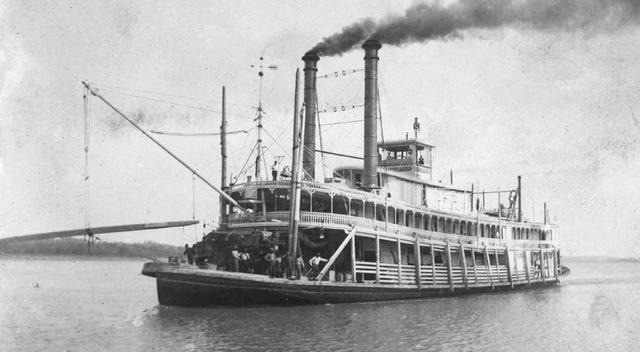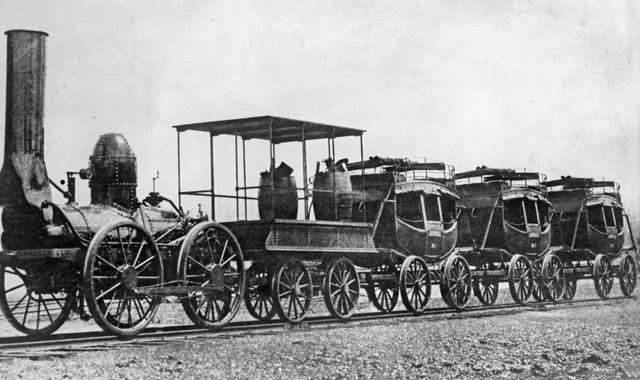【往期回顾】
【本期内容】
A brief history of transportation
交通运输工具的发展简史

Early history(早期历史)
Throughout most of human history, people’s movements on land were restricted to those speeds and distances that could be attained by walking. The use of sledges, pack animals, and then draft animals pulling wheeled vehicles increased the distance that early men could traverse and the amount of goods that they could transport.
在人类历史的大部分时间里,人们在陆地上的行动都局限于步行所能达到的速度和距离。雪橇、驮畜和畜力牵引的轮式车辆的使用增加了早期人类可以跨越的距离和他们可以运输的货物数量。
Long-distance transportation was mainly by water—on rivers and lakes, along seacoasts, and from island to island, usually in sight of land. Early vessels, propelled by currents and by paddles or poles, included rafts made of reeds or branches, boats made of skins, and dugout canoes. Later vessels used sails, which harnessed the wind. Extensive water commerce was carried on by the civilizations in ancient Phoenicia, around the Aegean Sea, and along the valleys of the Nile River in Egypt, the Tigris and Euphrates rivers in Mesopotamia, the Indus River (now in Pakistan), and the Yellow River in China.
长途运输主要通过水路——在河流和湖泊上,沿着海岸,从一个岛屿到另一个岛屿,通常在陆地的视线范围内。早期的船只由水流和桨或杆推动,包括芦苇或树枝制成的木筏、皮艇和独木舟。后来的船只使用帆来驾驭风。古代腓尼基、爱琴海周围、埃及尼罗河流域、美索不达米亚的底格里斯河和幼发拉底河、印度河(现巴基斯坦境内)和中国的黄河流域的文明进行了广泛的水贸易。

Some of the earliest long-distance overland trade routes date from around 2000 bc. These were the trails along which amber was carried from near the Baltic Sea to the Mediterranean and Aegean seas. Starting in the 6th century bc, the Persian rulers Cyrus and Darius built a road system in their empire. Around the end of the 4th century bc a road system was built in the Maurya Empire of India. Camel caravans carried silk from China to Europe on trails that perhaps predate the 4th century bc. By the 3rd century ad the road network of the Roman Empire had reached Britain, Gaul (modern France), and the eastern Mediterranean region.
一些最早的长途陆路贸易路线可以追溯到公元前2000年左右。这些是琥珀从波罗的海附近运往地中海和爱琴海的路径。从公元前6世纪开始,波斯统治者居鲁士和大流士在他们的帝国中建立了公路系统。大约在公元前4世纪末,印度的毛里亚帝国建立了一个公路系统。骆驼商队将丝绸从中国运往欧洲,其足迹可能早于公元前4世纪。到公元3世纪,罗马帝国的公路网已经到达英国、高卢(现代法国)和东地中海地区。
During the Middle Ages, improved sailing vessels and the magnetic compass made open-sea voyages out of sight of land much safer. Voyages of discovery in the 15th and 16th centuries greatly enlarged the world known to Europeans. An extensive sea trade developed, with merchant vessels carrying gold and silver from Latin America, tea and spices from Asia, and enslaved Black people captured from Africa.
在中世纪,改进的帆船和磁罗盘使陆地以外的公海航行更加安全。15世纪和16世纪的发现之旅极大地扩大了欧洲人所知的世界。广泛的海上贸易发展起来,商船从拉丁美洲运送金银,从亚洲运送茶叶和香料,从非洲运送捕获的黑奴。
Meanwhile, advances were being made in bridge and road construction, and the lock gate for canals was developed. Between the 16th and 18th centuries an extensive canal system was built in France. Transportation improvements in 18th-century Great Britain included the establishment of a turnpike (toll road) system and the use of iron for bridge construction. In 1815, John Loudon MacAdam first built a macadamized road, surfaced with compacted broken stone.
与此同时,桥梁和公路建设取得了进展,运河闸门也得到了开发。在16世纪至18世纪之间,法国修建了一个广泛的运河系统。18世纪英国的交通改善包括建立收费公路系统和使用铁建造桥梁。1815年,约翰·劳登·麦克亚当第一次建造了一条简易铺装的公路,路面是压实的碎石。
The American Indians did not have wheeled vehicles. Some tribes carried goods on an A-shaped drag called a travois. Indian trails often followed animal trails. For inland water transportation the Indians and later the European colonists used dugout, bark, or skin canoes.
美国印第安人没有轮式车辆。一些部落用一种叫做畜力雪橇的A形拖具运送货物。印第安人的足迹经常跟在动物的足迹后面。对于内陆水上运输,印第安人和后来的欧洲殖民者使用独木舟、树皮或皮划艇。
Late in the 18th century gravel roads were introduced in the United States. One of the first was a toll road, the Lancaster Turnpike in Pennsylvania. Plank roads and corduroy roads, made of lumber or logs laid side by side on the roadbed to overcome dust and mud, were built in the 1830s and 1840s. By the early 1800s transportation was being provided by animal-drawn Conestoga wagons and stagecoaches.
18世纪后期,美国引入了碎石路。第一条是收费公路,宾夕法尼亚州的兰开斯特收费公路。栈道和木排路建于19世纪30年代和19世纪40年代,由并排铺设在路基上的木材或原木制成,以抑制灰尘和泥土。到19世纪初,运输由动物牵引的康内斯托加式宽轮大篷马车和驿站马车提供。
Flatboats were common on inland waterways. The opening of the Erie Canal in 1825 heralded a great era of canal building that linked the Atlantic seaboard with the lands west of the Appalachians. After 1818, packet ships regularly sailed across the Atlantic to Europe. In the mid-1800s, fast, efficient clipper ships were built to sail from Atlantic ports around South America to California and Asia.
平底船在内陆水道上很常见。1825年伊利运河的开通预示着一个连接大西洋海岸和阿巴拉契亚山脉以西土地的运河建设的伟大时代。1818年后,包船定期穿越大西洋前往欧洲。19世纪中期,建造了快速高效的飞剪船,从南美洲周围的大西洋港口驶向加利福尼亚和亚洲。

Steam power(蒸汽动力)
The use of steam power to drive vehicles was applied as early as 1769 when a Frenchman, Nicolas Cugnot, demonstrated a steam carriage intended for use on common roads. It was in water transportation, however, that the early use of steam power was the most successful and enduring.
早在1769年,法国人尼古拉斯·库尼奥就开始使用蒸汽动力驱动车辆,当时他展示了一辆用于普通道路的蒸汽四轮车。然而,蒸汽动力的早期使用是在水运领域最成功、最持久的。
A short-lived steamboat service was begun by John Fitch on the Delaware River in 1790. In 1807 Robert Fulton established a successful steamboat line on the Hudson River. By the 1820s, steamboats plied the Great Lakes and the rivers of the Mississippi and Ohio valleys. Along with the development of canals, their use greatly reduced shipping costs to and from the interior and helped open vast areas of North America to settlement. During that same time, steamships were introduced onto European sea routes. The first oceangoing steamship, the Savannah, crossed the Atlantic from Savannah, Ga., to Liverpool, England, in 1819, although it used sails for most of the voyage. By the 1840s, vessels were crossing the Atlantic entirely by steam power. In 1840 Samuel Cunard established the first regularly scheduled steamship line between England and North America. These early steamships were wooden and were propelled by side paddle wheels. They were primarily passenger and mail ships, since their cargo capacity was limited by the large space needed to carry coal for fuel on long ocean voyages.
1790年,约翰·费奇在特拉华河上开始了一项短暂的蒸汽船业务。1807年,罗伯特·富尔顿在哈德逊河上建立了一条成功的蒸汽船航线。到19世纪20年代,蒸汽船往返于五大湖以及密西西比河和俄亥俄河流域。随着运河的发展,运河的使用大大降低了往返内陆的运输成本,并有助于北美大片地区的定居。在同一时期,蒸汽船被引入欧洲海上航线。1819年,第一艘远洋蒸汽船“萨凡纳”号从佐治亚州萨凡纳穿越大西洋到达英国利物浦,尽管它在大部分航行中都使用了帆。到19世纪40年代,船只完全依靠蒸汽动力横渡大西洋。1840年,塞缪尔·库纳德建立了第一条定期往返于英格兰和北美的蒸汽船航线。这些早期的蒸汽船是木制的,由侧桨轮推动。它们主要是客船和邮船,因为它们的货运能力受到长途远洋运输煤炭所需的巨大空间的限制。
With the adoption of the speedier screw propeller, the building of stronger iron-hulled vessels, and the establishment of coaling stations along their routes, ocean steamships by the 1890s had exceeded sailing ships in tonnage carried. Sailing ships soon were eliminated from long-distance ocean trade.
随着更快的螺旋桨的采用,更坚固的铁壳船的建造,以及在其航线上建立加煤站,到19世纪90年代,远洋蒸汽船的吨位已经超过了帆船。帆船很快就被长途海洋贸易淘汰了。
New, shorter ocean routes were established. The Suez Canal, opened in 1869, enabled vessels to bypass the long voyage around Africa on routes between Europe and Asia. The Panama Canal, opened in 1914, bypassed the voyage around South America on routes between Atlantic and Pacific ports.
新的、更短的海运路线被建了起来。苏伊士运河开通于1869年,使船只能够绕过欧洲和亚洲之间的非洲长途航行。巴拿马运河开通于1914年,绕过大西洋和太平洋港口之间的南美洲航线。

Growth of railroads(铁路的发展)
Railroads were used in European mines as early as the mid-1500s. Men or animals pushed wagons loaded with ore along wooden tracks. Later, iron tracks were used and, with the advent of steam power, wagons were hauled by ropes connected to stationary engines. In Wales in 1804, Richard Trevithick demonstrated the first successful railroad steam locomotive. In 1825 the Stockton and Darlington railway near Newcastle, England, became the first common carrier to use steam locomotives.
早在15世纪中期,铁路就被用于欧洲的矿山。人力或牲畜推着满载矿石的车厢沿着木制轨道前行。后来,人们使用了铁轨,随着蒸汽动力的出现,车厢被连接到固定发动机上的绳索牵引。1804年,理查德·特雷维西克在威尔士展示了第一台成功的铁路蒸汽机车。1825年,英国纽卡斯尔附近的斯托克顿和达林顿铁路成为第一条使用蒸汽机车的普通运输工具。
In the United States the Baltimore and Ohio Railroad and the South Carolina Railroad began operation in 1830. Like the early roads, they were inland feeders to ports. Railroads spread rapidly in the eastern and southern United States, with short lines being merged to form through routes. By the mid-1850s, railways linked the Atlantic seaboard and the Midwest. In 1869 the first transcontinental route was completed to the Pacific coast.
在美国,巴尔的摩和俄亥俄铁路以及南卡罗来纳铁路于1830年开始运营。就像早期的公路一样,它们是通往港口的内陆支线。铁路在美国东部和南部迅速蔓延,短线路被合并成直通线路。到19世纪50年代中期,铁路连接了大西洋沿岸和中西部。1869年,通往太平洋海岸的第一条横贯大陆的路线建成。
Railroads became the dominent mode of overland transportation in the last half of the 19th century. Faster and more powerful locomotives and larger freight and passenger cars were built. Standardization of track gauges and the adoption of standard time zones aided efficiency. The invention of air brakes, automatic signaling, and the automatic coupler increased safety. Sleeping cars and dining cars increased passenger comfort and convenience.
19世纪下半叶,铁路成为主要的陆路运输方式。建造了更快、更强大的机车和更大的货车和客车。轨距的标准化和标准时区的采用有助于提高效率。空气制动器、自动信号和自动耦合器的发明提高了安全性。卧铺车和餐车增加了乘客的舒适性和便利性。
In 1832 the horse-drawn tramcar on rails was adopted in New York City and in the following decades became widely accepted as an inexpensive form of public urban transportation. In the 1870s, steam-powered cable-drawn trams became popular. Beginning in 1863 in London, England, steam-powered underground railways (subways) were built.
1832年,有轨电车在纽约市被采用,并在接下来的几十年里被广泛接受为一种廉价的城市公共交通方式。19世纪70年代,蒸汽动力电缆牵引电车开始流行起来。1863年,英国伦敦开始修建蒸汽动力地下铁路(地铁)。
Electric power was introduced to land transportation in the mid-1880s when electric street railways began operating in the United States, Canada, and Europe. By 1900 they had replaced horsecars and cable cars as the chief form of urban transportation. Electrified elevated or subway lines were built in several European cities and in Boston, Chicago, and New York City. Electrification spread early in the 20th century to intercity railroad lines but later the diesel-electric locomotive became dominant in the United States. By the 1950s, the automobile, bus, and airplane had replaced the railroad train as the principal passenger carriers in the United States. Trucks, waterways, and pipelines also competed increasingly with railroads in freight hauling.
19世纪80年代中期,电力被引入陆地交通,当时电动街道铁路开始在美国、加拿大和欧洲运营。到1900年,他们已经取代马车和缆车成为城市交通的主要形式。几个欧洲城市以及波士顿、芝加哥和纽约市都修建了电气化高架或地铁线路。20世纪初,电气化蔓延到城际铁路线路,但后来柴电机车在美国占主导地位。到20世纪50年代,汽车、公共汽车和飞机已经取代铁路列车成为美国的主要客运工具。卡车、水路和管道运输在货运方面也与铁路竞争日益激烈。

The automobile and the air age(汽车和飞机时代)
Some of the first successful gasoline automobiles were developed in Germany by Karl Benz and Gottlieb Daimler in the 1880s and in the United States by Charles E. and J. Frank Duryea in 1893. Although some early automobiles were powered by steam and electricity, the internal-combustion gasoline engine soon became the favored form of motive power.
19世纪80年代,卡尔·奔驰和戈特利布·戴姆勒在德国开发了一些最早成功的汽油汽车,1893年,查尔斯·E和J·弗兰克·杜耶在美国开发了一些汽油汽车。尽管一些早期的汽车是由蒸汽和电力驱动的,但内燃汽油发动机很快就成为了最受欢迎的动力形式。
The early farm-to-market roads in the countryside were rarely paved. By the 1890s, however, some roads near the cities were being paved in response to the growing popularity of bicycle riding. As the automobile came into common use in the 1900s, 1916 the Federal Aid Road Act provided for massive federal aid in highway construction. Limited-access express highways originated in Europe in the 1920s and 1930s with the building of the first Italian autostrada and German autobahn. One of the first expressways in the United States was the Pennsylvania Turnpike, opened in 1940. The Federal-Aid Highway Act of 1956 and later amendments provided for a network of 42,500 miles of interstate expressways to be completed by the mid-1970s.
农村早期从农场到市场的道路很少铺设。然而,到19世纪90年代,为了应对骑自行车日益流行的趋势,城市附近的一些道路开始铺设。随着汽车在20世纪开始广泛使用,1916年的《联邦援助道路法》规定了联邦政府对高速公路建设的大规模援助。20世纪20年代和30年代,随着意大利第一条高速公路和德国高速公路的建成,通行受限的高速公路在欧洲起源。宾夕法尼亚收费公路是美国最早的高速公路之一,于1940年开通。1956年的《联邦援助高速公路法》和后来的修正案规定,到20世纪70年代中期,将建成42500英里的州际高速公路网络。
The first successful manned, engine-powered flight in a heavier-than-air craft was achieved in 1903 at Kitty Hawk, N.C., by Orville and Wilbur Wright. Airplanes were used in combat during World War I. Regular airmail routes began in the United States in 1918. During the 1920s and 1930s, mail planes commonly carried passengers. In the 1930s, scheduled flights were begun over the Atlantic and Pacific oceans.
1903年,奥维尔和威尔伯·赖特在北卡罗来纳州的基蒂霍克成功地进行了第一次载人、发动机驱动的重于空气的飞行器飞行。第一次世界大战期间,飞机被用于作战。1918年,美国开始了定期邮件航线。在20世纪20年代和30年代,邮航飞机通常搭载乘客。20世纪30年代,大西洋和太平洋开始了定期航班。
The development during World War II of multiengine long-distance planes, aided by reliable electronic navigation and weather forecasting, led to the rapid advance of commercial air transportation. As a result, shipping lines rapidly declined as major passenger carriers.
第二次世界大战期间,多引擎长途飞机的发展,在可靠的电子导航和天气预报的帮助下,带来了商业航空运输的快速发展。因此,船运公司作为主要客运公司迅速衰落。
With the introduction of jet power to commercial air service in the 1950s, speeds were doubled and costs were greatly reduced. Propeller planes were largely replaced on major transcontinental and trans-oceanic routes. The testing of supersonic jet transports began in Europe and the United States in the late 1960s. During that same time, jumbo jet aircraft, with capacities of nearly 500 passengers each, were brought into service.
随着喷气动力在20世纪50年代引入商业航空服务,速度提高了一倍,成本也大大降低。螺旋桨飞机在主要的跨大陆和跨洋航线上被大量取代。超音速喷气运输机的测试始于20世纪60年代末的欧洲和美国。与此同时,每架可搭载近500名乘客的大型喷气式飞机投入使用。

Advances in transportation(交通运输的进步)
Technological advances in transportation have included the development of superspeed trains, such as Japan’s “bullet train” of the 1960s and France’s TGV (Train de Grand Vitesse) of the 1970s and 1980s. These advances gave engineers the inspiration to design such experimental railroad systems as the magnetic levitation, or maglev, train, which by the early 1990s had only short test systems set up in Germany and Japan. Improvements in power generation and transmission and concern for the air and noise pollution caused by diesel engines have prompted automobile makers to develop cars that will run on alternative types of fuel. One result has been the prototype of an electric car.
交通运输的技术进步包括超高速列车的发展,如20世纪60年代的日本“子弹头列车”和20世纪70年代和80年代的法国TGV(大维特斯列车)。这些进步给了工程师设计磁悬浮列车等实验性铁路系统的灵感,到20世纪90年代初,磁悬浮列车只有在德国和日本建立的短期测试系统。发电和变速器的改进,以及对柴油发动机造成的空气和噪音污染的担忧,促使汽车制造商开发出使用替代燃料的汽车。结果之一就是电动汽车的原型。
A greater variety of ships, including submarine tankers and fast, multiple-hulled surface ships, have been developed. Other new types of vessels that are available include the hydrofoil, which travels on sea wings with its hull above water, and the surface-effect ship, or hovercraft, which rides above the water on a cushion of air.
更多种类的船只已经开发出来,包括潜艇油轮和快速多体的水面舰船。其他可用的新型船只包括水翼船和水面效应船,前者依靠浮翼航行,船体在水面上,后者依靠气垫在水面上飞行。
The widespread use of atomic power for ship propulsion is a major research goal. STOL (short takeoff and landing), VTOL (vertical takeoff and landing), and supersonic aircraft have been adopted. These new technologies have made vehicles quieter. Passenger travel has improved in speed and comfort. Freight transport costs less because larger vehicles are used and operating efficiency has increased. The computer is used for record keeping, traffic control, navigation, and other routine operations.
原子能在船舶推进中的广泛使用是一个主要的研究目标。STOL(短距起降)、VTOL(垂直起降)和超音速飞机已被采用。这些新技术使车辆变得更安静。乘客出行的速度和舒适度都有所提高。货运成本降低,因为使用了更大的车辆,运营效率提高了。计算机用于记录、交通控制、导航和其他日常操作。
In the more distant future, rocket transportation may become feasible, perhaps in combination with orbiting satellites, enabling all points on Earth to be connected in less than an hour’s travel time. Underground gravity vacuum tubes may permit freight and passengers to travel between stations thousands of miles apart also in less than an hour.
在更遥远的未来,火箭运输可能会变得可行,也许可以与轨道卫星相结合,使地球上的所有点都能在不到一小时的旅行时间内连接起来。地下重力真空管可以让货物和乘客在相距数千英里的车站之间旅行,也不到一个小时。
Improvements may be expected in transportation management techniques. Some forms of transportation now under private ownership, management, and operation will increasingly depend on public financing or control, just as urban mass transit now does. Some forms of transportation will be integrated into multimodal organizations, both public and private, in order to move people and goods with a minimum of cost, inconvenience, and delay.
运输管理技术有望得到改进。现在由私人所有、管理和运营的一些交通形式将越来越依赖公共融资或控制,就像现在的城市公共交通一样。一些运输形式将整合到公共和私人的多式联运组织中,以便以最低的成本、不便和延误运送人员和货物。
The need for modes of transportation will endure. Innovative communications systems, however, have already made much travel unnecessary. Teleconferencing enables people to hold meetings and see each other without having to travel. Computer networking makes cooperative work possible, without the workers leaving home or office.
对交通方式的需求将持续下去。然而,创新的通信系统已经使许多旅行变得不必要。电话会议使人们能够在不必旅行的情况下举行会议和见面。计算机网络使合作工作成为可能,而不需要工人离开家或办公室。

【Source】www.kids.britannica.com
【Translated by】Spark Liao (廖怀宝)
【Illustration】From Bing

